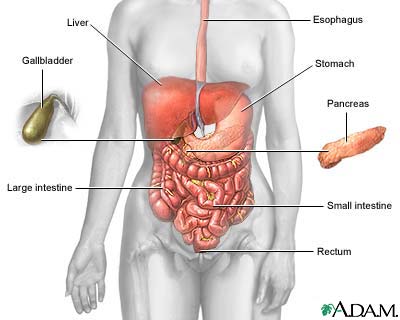Alternate Names : Biliary obstruction
Definition
Bile duct obstruction is a blockage in the tubes that carry bile from the liver to the gallbladder and small intestine.
Overview, Causes, & Risk Factors
Bile is a liquid released by the liver. It contains cholesterol, bile salts, and waste products such as bilirubin. Bile salts help your body break down (digest) fats. Bile passes out of the liver through the bile ducts and is stored in the gallbladder. After a meal, it is released into the small intestine.
When the bile ducts become blocked, bile builds up in the liver, and jaundice (yellow color of the skin) develops due to the increasing levels of bilirubin in the blood.
The possible causes of a blocked bile duct include:
- Cysts of the common bile duct
- Enlarged lymp nodes in the porta hepatis
- Gallstones
- Inflammation of the bile ducts
- Trauma including injury from gallbladder surgery
- Tumors of the bile ducts or pancreas
- Other tumors that have spread to the biliary system
The risk factors include:
- History of gallstones, chronic pancreatitis, or pancreatic cancer
- Injury to the abdominal area
- Recent biliary surgery
- Recent biliary cancer (such as bile duct cancer)
The blockage can also be caused by infections. This is more common in persons with weakened immune systems.
Pictures & Images
Digestive system
 The esophagus, stomach, large and small intestine, aided by the liver, gallbladder and pancreas convert the nutritive components of food into energy and break down the non-nutritive components into waste to be excreted.
The esophagus, stomach, large and small intestine, aided by the liver, gallbladder and pancreas convert the nutritive components of food into energy and break down the non-nutritive components into waste to be excreted.
Endocrine glands

Endocrine glands release hormones (chemical messengers) into the bloodstream to be transported to various organs and tissues throughout the body. For instance, the pancreas secretes insulin, which allows the body to regulate levels of sugar in the blood. The thyroid gets instructions from the pituitary to secrete hormones which determine the pace of chemical activity in the body (the more hormone in the bloodstream, the faster the chemical activity; the less hormone, the slower the activity).
Bile pathway

The biliary system is comprised of the organs and duct system that create, transport, store and release bile into the duodenum for digestion. Includes the liver, gallbladder and bile ducts (named the cystic, hepatic, common, and pancreatic duct).
Biliary obstruction – series
Normal anatomy

Bile is a digestive fluid secreted by the liver and stored in the gallbladder which normally is released into the duodenum portion of the small intestine through the sphincter of Oddi. Bile, released after a meal containing fats, aids in absorption and digestion of the fat.
-
Bile duct obstruction : Overview, Causes, & Risk Factors
-
Bile duct obstruction : Symptoms & Signs, Diagnosis & Tests
-
Bile duct obstruction : Treatment



Review Date : 9/20/2008
Reviewed By : David C. Dugdale, III, MD, Professor of Medicine, Division of General Medicine, Department of Medicine, University of Washington School of Medicine. Also reviewed by David Zieve, MD, MHA, Medical Director, A.D.A.M., Inc.
